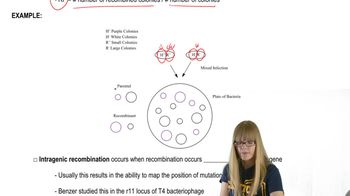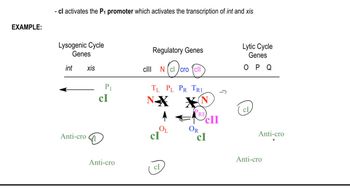In good growth conditions the bacteriophage is more likely to enter into which life cycle?
Table of contents
- 1. Introduction to Genetics51m
- 2. Mendel's Laws of Inheritance3h 37m
- 3. Extensions to Mendelian Inheritance2h 41m
- 4. Genetic Mapping and Linkage2h 28m
- 5. Genetics of Bacteria and Viruses1h 21m
- 6. Chromosomal Variation1h 48m
- 7. DNA and Chromosome Structure56m
- 8. DNA Replication1h 10m
- 9. Mitosis and Meiosis1h 34m
- 10. Transcription1h 0m
- 11. Translation58m
- 12. Gene Regulation in Prokaryotes1h 19m
- 13. Gene Regulation in Eukaryotes44m
- 14. Genetic Control of Development44m
- 15. Genomes and Genomics1h 50m
- 16. Transposable Elements47m
- 17. Mutation, Repair, and Recombination1h 6m
- 18. Molecular Genetic Tools19m
- 19. Cancer Genetics29m
- 20. Quantitative Genetics1h 26m
- 21. Population Genetics50m
- 22. Evolutionary Genetics29m
12. Gene Regulation in Prokaryotes
Lambda Bacteriophage and Life Cycle Regulation
Problem 6
Textbook Question
Describe the difference between the bacteriophage lytic cycle and lysogenic cycle.
 Verified step by step guidance
Verified step by step guidance1
Understand that bacteriophages are viruses that infect bacteria, and they can follow two distinct life cycles: the lytic cycle and the lysogenic cycle.
In the lytic cycle, the bacteriophage attaches to the bacterial cell, injects its genetic material, and uses the host's cellular machinery to replicate its DNA and produce new viral particles. This process ultimately leads to the lysis (bursting) of the bacterial cell, releasing the new phages.
In the lysogenic cycle, the bacteriophage integrates its genetic material into the bacterial host's genome, forming a prophage. The viral DNA remains dormant and is replicated along with the host's DNA during cell division, without causing immediate harm to the host.
Recognize that environmental factors, such as stress or UV radiation, can trigger the prophage in the lysogenic cycle to exit the host genome and enter the lytic cycle, leading to active replication and cell lysis.
Summarize the key difference: the lytic cycle results in the destruction of the host cell and immediate production of new viruses, while the lysogenic cycle involves integration of viral DNA into the host genome and a dormant phase before potentially transitioning to the lytic cycle.
 Verified video answer for a similar problem:
Verified video answer for a similar problem:This video solution was recommended by our tutors as helpful for the problem above
Video duration:
2mPlay a video:
Was this helpful?
Key Concepts
Here are the essential concepts you must grasp in order to answer the question correctly.
Bacteriophage Structure and Function
Bacteriophages, or phages, are viruses that specifically infect bacteria. They consist of genetic material (DNA or RNA) encased in a protein coat. Understanding their structure is crucial for comprehending how they interact with bacterial cells during the lytic and lysogenic cycles.
Recommended video:
Guided course

Mapping Bacteriophages
Lytic Cycle
The lytic cycle is a viral reproductive process where the bacteriophage infects a bacterial cell, hijacks its machinery to replicate its own genetic material, and ultimately causes the cell to burst (lyse), releasing new phage particles. This cycle results in the immediate destruction of the host cell.
Recommended video:
Guided course

Decision Between Lytic and Lysogenic Cycles
Lysogenic Cycle
In contrast, the lysogenic cycle involves the integration of the phage's genetic material into the bacterial genome, forming a prophage. This allows the phage to replicate along with the bacterial DNA without killing the host. The lysogenic cycle can switch to the lytic cycle under certain conditions, leading to cell lysis.
Recommended video:
Guided course

Decision Between Lytic and Lysogenic Cycles

 4:29m
4:29mWatch next
Master Bacteriophage Life Cycle with a bite sized video explanation from Kylia
Start learningRelated Videos
Related Practice
Multiple Choice
321
views
1
rank
